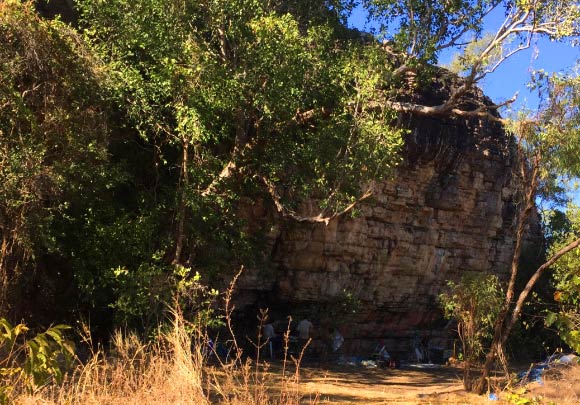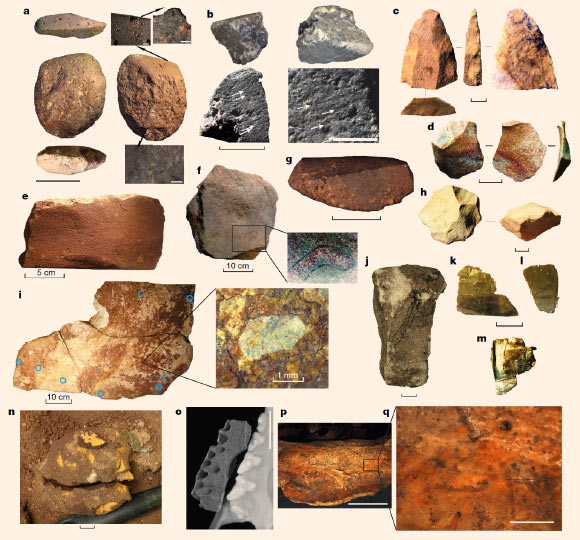New evidence from a rockshelter in northern Australia shows human occupation of the continent for at least 65,000 years — much longer than other estimates of closer to 50,000 years.

Photograph of the Madjedbebe rockshelter during the 2015 excavation. Image credit: Clarkson et al, doi: 10.1038/nature22968.
The discovery was made by a team of archaeologists and dating specialists led by University of Queensland researcher Dr. Chris Clarkson.
The team found new evidence at the Madjedbebe rockshelter in the World Heritage-listed Kakadu National Park, near Jabiru in northern Australia.
“This latest evidence pushes back the initial human occupation estimate by some 10,000 years or more, and supports a longer Aboriginal connection with the continent than previously thought,” said team member Dr. Lee Arnold, from the University of Adelaide.
“Intriguingly, the new occupation age implies at least 20,000 years of overlap between humans and the megafauna in the far north of Australia.”
“The evidence suggests that the causes of Australian megafauna extinction may be much more complex than is often assumed.”
“The new date makes a difference,” said team member Dr. Ben Marwick, from the University of Washington.
“Against the backdrop of theories that place humans in Australia anywhere between 47,000 and 60,000 years ago, the concept of earlier settlement calls into question the argument that humans caused the extinction of unique megafauna such as giant kangaroos, wombats and tortoises more than 45,000 years ago.”
“Previously it was thought that humans arrived and hunted them out or disturbed their habits, leading to extinction, but these dates confirm that people arrived so far before that they wouldn’t be the central cause of the death of megafauna.”
“It shifts the idea of humans charging into the landscape and killing off the megafauna. It moves toward a vision of humans moving in and coexisting, which is quite a different view of human evolution.”

Artifacts from the 2012 and 2015 excavations at the Madjedbebe rockshelter. Scale bars are 1 cm unless indicated otherwise. (a) ground hatchet head. Scale bar – 5 cm. Top insets and micrographs show striations and grinding (left; scale bar – 2 mm) and edge rounding and polish from use (right; scale bar – 0.2 mm). Bottom micrograph and inset show polish (scale bar – 0.2 mm) from movement inside the haft. (b) edge-ground margin on flake. Scale bar – 5 mm. Bottom-right inset (scale bar – 2 mm) shows striations (arrows) from use and grinding. Top-left, the ground edge is shown viewed from the side. Top-right, the ground edge is shown viewed from the front. (c) invasively retouched silcrete point. (d) silcrete thinning flake. (e) sandstone grinding stone. (f) mortar, used to pound hard plant material and with possible outline motif in the bottom-right corner. (g) ground ochre ‘crayon.’ (h) faceted discoidal core. (i) conjoining ochre-covered slab; inset shows fragment of mica embedded in a thick coating of ochre, with blue circles at the < 8.5-mm-diameter pXRF sampling locations. (j) charcoal lines and dots on sandstone piece. (k-m) pieces of sheet mica found wrapped around a large, ground yellow ochre ‘crayon’ (n). (o-q) photographs of a maxillary fragment of a thylacine (Thylacinus cynocephalus), coated in red pigment. (o) archaeological specimen (left) is shown relative to a modern thylacine cast. (p) and (q) detail of ochred surface at 6.7x magnification (scale bar – 10 mm) and 45x magnification (scale bar – 1 mm), respectively. The probable age of the thylacine specimen is 2,700-3,900 years before present, as indicated by 14C ages. Image credit: Clarkson et al, doi: 10.1038/nature22968.
The Madjedbebe rockshelter, also known as Malakunanja II, has been excavated four times since the 1970s.
More than 10,000 artifacts were revealed at the site, including the oldest ground-edge stone axe technology in the world and the oldest known seed-graining tools in Australia.
“The site contains the oldest ground-edge stone axe technology in the world, the oldest known seed-grinding tools in Australia and evidence of finely made stone points which may have served as spear tips,” Dr. Clarkson said.
“Most striking of all, in a region known for its spectacular rock art, are the huge quantities of ground ochre and evidence of ochre processing found at the site, from the older layer continuing through to the present.”
“Aboriginal people lived at Madjedbebe at the same time as extinct species of giant animals were roaming around Australia, and the tiny species of primitive human, Homo floresiensis, was living on the island of Flores in eastern Indonesia,” the researchers said.
The dig also discovered an upper jaw fragment of a thylacine (also known as the Tasmanian tiger) coated in red pigment, giving insight to the central role ochre played in local customs at the time.
“Our team has rewritten Australian and, indeed, world history by proving that the colonization of Australia and the first major sea voyage in human history occurred at least 65,000 years ago,” said team member S. Anna Florin, a PhD student at the University of Queensland.
“This incredible discovery, and its many implications, is the work of many archaeologists, using small pieces of evidence such as stone tools and grains of sand to understand human behavior many millennia ago.”
“The new evidence sets a new minimum age for the arrival of humans in Australia, the dispersal of modern humans out of Africa, and the subsequent interactions of modern humans with Neanderthals and Denisovans,” the scientists said.
The research is published in the journal Nature.
_____
Chris Clarkson et al. 2017. Human occupation of northern Australia by 65,000 years ago. Nature 547: 306-310; doi: 10.1038/nature22968







